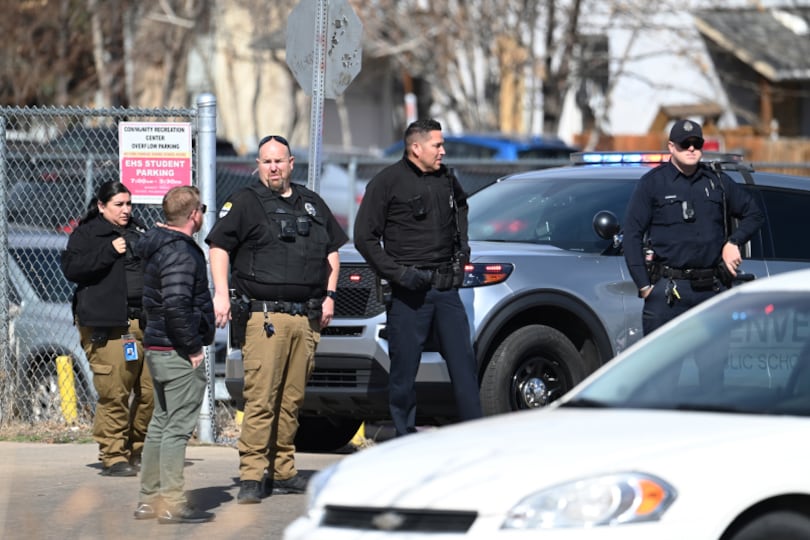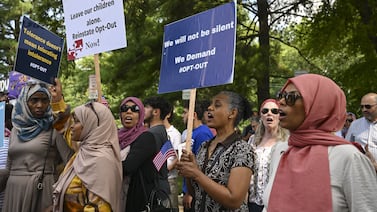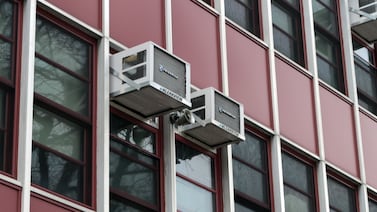When a Denver teen shot and injured two school administrators on Wednesday, it marked the third time this year that gun violence had rocked East High, the city’s largest high school.
For the schools superintendent, it signaled the need for a dramatic shift in district policy: the return of police at comprehensive high schools for the remainder of the school year.
“I can no longer stand on the sidelines,” Alex Marrero wrote in a letter to the school board, which voted in 2020 to remove police from schools. The city’s mayor quickly backed the decision, and even a local group long opposed to police in schools acknowledged that acts of violence “force hard conversations.” On Thursday, the school board agreed to temporarily lift its ban on school police.
The turnabout in Denver echoes recent decisions to bring back school police by a few other districts across the U.S. In some cases, as in Denver, these debates are coming to a head after a shooting or other act of violence on campus erodes support.
Many other districts have stayed the course. But with more communities nationwide facing upticks in gun violence, and in a moment with far less political attention being paid to racism and policing, it remains unclear if changes elsewhere will be walked back.
“It makes sense that communities are really struggling following incidents like this — they are traumatic and scary,” said Katherine Dunn of The Advancement Project, a nonprofit that has advocated for the removal of police from schools. Bringing back police can be a quick, visible way for school leaders to demonstrate they are being reactive in a moment of crisis. “Every time this happens,” she said, policing is “the one thing that we know to go back to and try again.”
School leaders, families, students, and community groups have long wrestled with what role police should play in schools.
School shootings have prompted schools to add guards and police in an effort to stop future violence, though their track record is mixed. By 2019, just over half of U.S. schools had at least one armed officer present, according to a federal survey. But having police in school has also been shown to increase arrests and suspensions, with Black students most likely to be arrested at school and less likely to feel safer when police were around.
According to a tracker compiled by Education Week, at least 50 school districts eliminated school police or significantly reduced their school policing budgets from May 2020 through June 2022, following the murder of George Floyd and the ensuing racial justice protests of 2020.
Denver was one of several school districts that removed or scaled back the presence of school police during that period. The district canceled its contract with the city’s police department and officers were removed from schools by June 2021.
Eight districts ended up bringing back school police, EdWeek found, at least three of which reversed course in response to shootings or the presence of weapons at or near schools.
These debates are often complicated and play out differently depending on the community.
Some in Denver were questioning whether the school district should revisit its relationship with the police even before this week’s tragedy.
In Portland, Oregon, where the school district removed police from schools in 2020, the mayor said in December that talks were in the works to possibly bring officers back after students were shot outside two different high schools.
Montgomery County schools in Maryland brought back police following a shooting at a high school in January 2022 that injured a student.
And Alexandria City schools in Virginia temporarily reinstated police following several student fights and an incident in which a student had a handgun outside the city’s high school. The debate continued after a student was stabbed to death outside the same school. In January, an advisory group ultimately recommended that the district keep police in schools, in part to show families the district was taking those violent incidents seriously.
In those cases, police returned with some new requirements in place. Montgomery County, for example, limited which incidents police could get involved in, while Alexandria is poised to require that school police receive de-escalation training.
Elsewhere, changes have stuck. In Los Angeles, the district cut its policing budget by more than a third and reinvested that money into an initiative to boost Black student achievement. That includes hiring hundreds of new social workers, counselors, and other staff for schools that enroll large percentages of Black students. Some students have reported feeling more relaxed seeing those mental health staffers on campus instead of police.
“I feel like a big part of their purpose is to help you feel comfortable in your skin,” one 16-year-old student told Capital B.
Still, conversations about the future of school police are ongoing in lots of places. In Washington D.C., where the city has been shrinking its school police force, the mayor tried and failed to reverse the measure last year and is set to try again. In Chicago, decisions are being made at the school level, and 40 schools will decide whether to continue having police on campus in the next few months.
In Denver, the board suspended its policy prohibiting police in schools through the end of June. It also directed the superintendent to engage with students, families, and teachers, and to seek funding for additional mental health staff.
Dunn says while many schools have experimented with removing police, they have a longer way to go to figure out how to staff and fund alternatives to police.
“The systems transformation that is required to actually have schools be safe places — I don’t really see that happening,” she said.
Sarah Darville contributed reporting.
Kalyn Belsha is a national education reporter based in Chicago. Contact her at kbelsha@chalkbeat.org.





